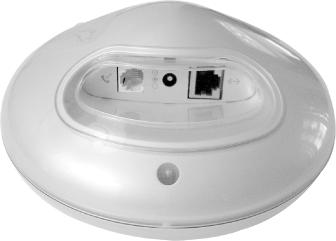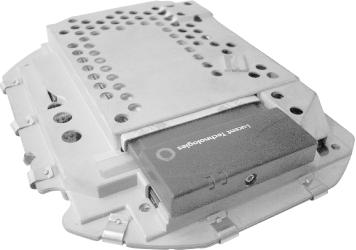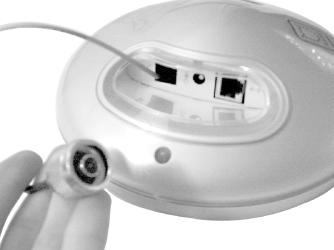Significantly extend your range when using an AirPort base station.
As stated many times in this book, the single most effective method for extending range is to use a good antenna. Most access points ship with a simple dipole or small omni that doesn’t offer much gain, but at least gets the antenna away from the body of the access point. The Apple AirPort is a somewhat expensive AP that includes an integrated antenna but no external antenna connector. This state of affairs has been corrected on their newest AirPort Extreme models, which include an external antenna connector, but there are a huge number of older AirPorts deployed that rely on the internal antenna for communications.
Luckily, the radio inside the Graphite AirPort is a Lucent/Orinoco/Avaya Silver card, which includes an antenna connector of its own. With a little bit of work, it is possible add your own external antenna. All you need is a screwdriver, a dremel tool, a Lucent pigtail [Hack #66], and about half an hour.
As you can see in Figure 4-5, the only ports on the back of a Graphite AirPort are the modem, power, and Ethernet. The rest of the AirPort is sealed, and there isn’t room to squeeze a pigtail in without cutting a hole in the chassis. I found that I used the modem only once since I bought the AirPort, so rather than cut a hole in the side of the AirPort, I could just remove the telephone jack and feed the pigtail through the little square.
There are three Philips head screws on the bottom of the AirPort. Remove them, and carefully remove the bottom half of the shell. There is an internal case that is held to the top by three more screws. Remove them, but don’t tilt out the internal case yet. There is a tiny cable connecting the telephone jack to the motherboard, covered with a piece of silver metal tape. Pry up the tape, and carefully disconnect the modem connector. Now you should be able to carefully tilt out the internal case. This is the motherboard and radio card of the AirPort, which attaches to the ports by two short cables (an Ethernet cable and a twisted red and black power cable). Remove them as well.
If you have never played with a Lucent/Orinoco/Avaya Silver card before, there is a tiny black plastic cap covering the antenna connector on the edge of the card. Pry out this cap and discard it, as shown in Figure 4-6.
Notice how the radio card fits snugly against a black plastic rail on the top half of the outer shell. There isn’t enough room to accommodate a pigtail when reassembling the AirPort, so you need to grind away some of this plastic, or possibly use a good pair of cutters to nibble it away. A right-angle pigtail works much better than a straight pigtail, as there isn’t much room to maneuver inside the case.
If you would rather just punch a hole in the side of the AirPort case, you can do that now as well. I prefer to feed the pigtail through the modem port, which involves removing the entire port chassis. There are two screws holding a metal plate to the top half of the outer shell. Remove them, and the entire port chassis will pull out of the case. There are two tiny screws holding the telephone jack to this metal plate. You need a tiny Phillips head screwdriver to remove these screws. A jeweler’s screwdriver (as you might find in an eyeglass repair kit) works well.
Now reverse the steps, carefully tucking in the cables as you screw everything back together again. Figure 4-7 shows an 8” pigtail fed through the modem port.
I didn’t have one handy, but a better hack would be to use a chassis mount N or TNC connector to bolt directly to the modem port. That would be more rugged, and would help avoid the possibility of accidentally yanking too hard on the pigtail and damaging the connector or card. Also note that while a pigtail is connected to a Lucent card, the internal antenna is switched off, so you will get very terrible coverage unless you connect the pigtail to an antenna.
This technique can be used for other devices that include an internal card with antenna connectors, such as the Proxim RG1000 or RG1100. Many APs now come standard with external antennas, but if you should encounter one that doesn’t, this modification can improve your range significantly.
Get Wireless Hacks now with the O’Reilly learning platform.
O’Reilly members experience books, live events, courses curated by job role, and more from O’Reilly and nearly 200 top publishers.




